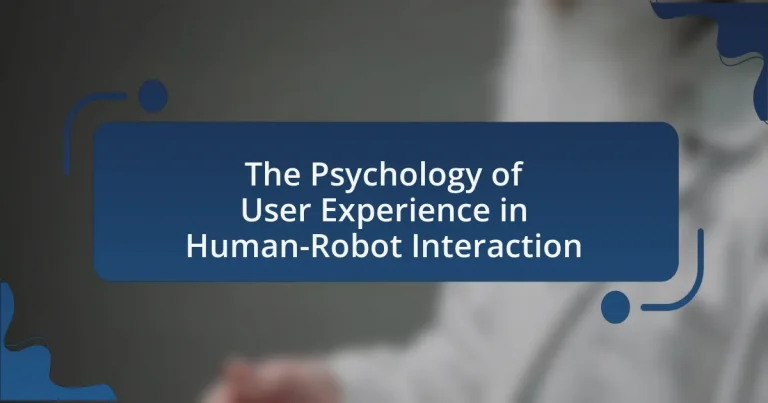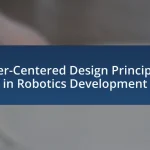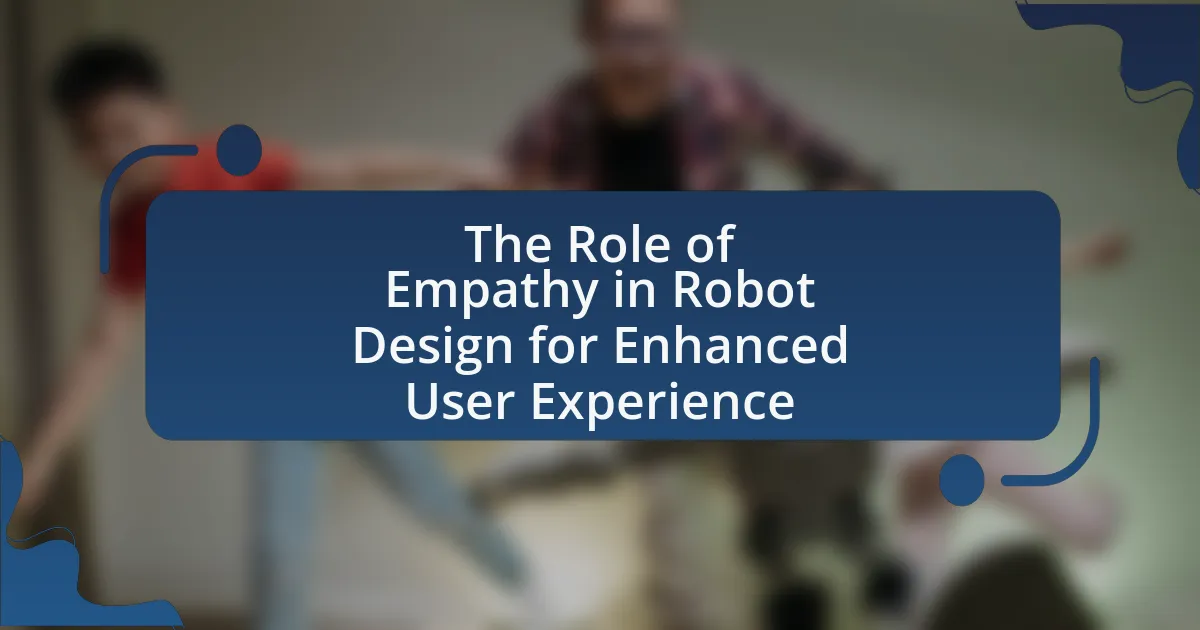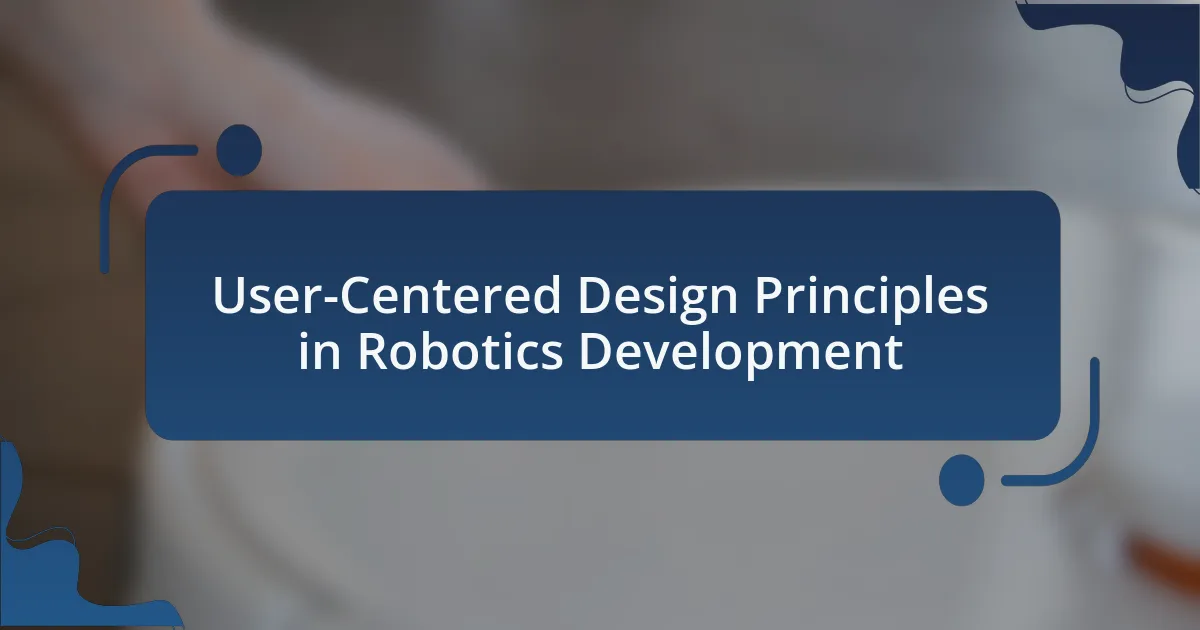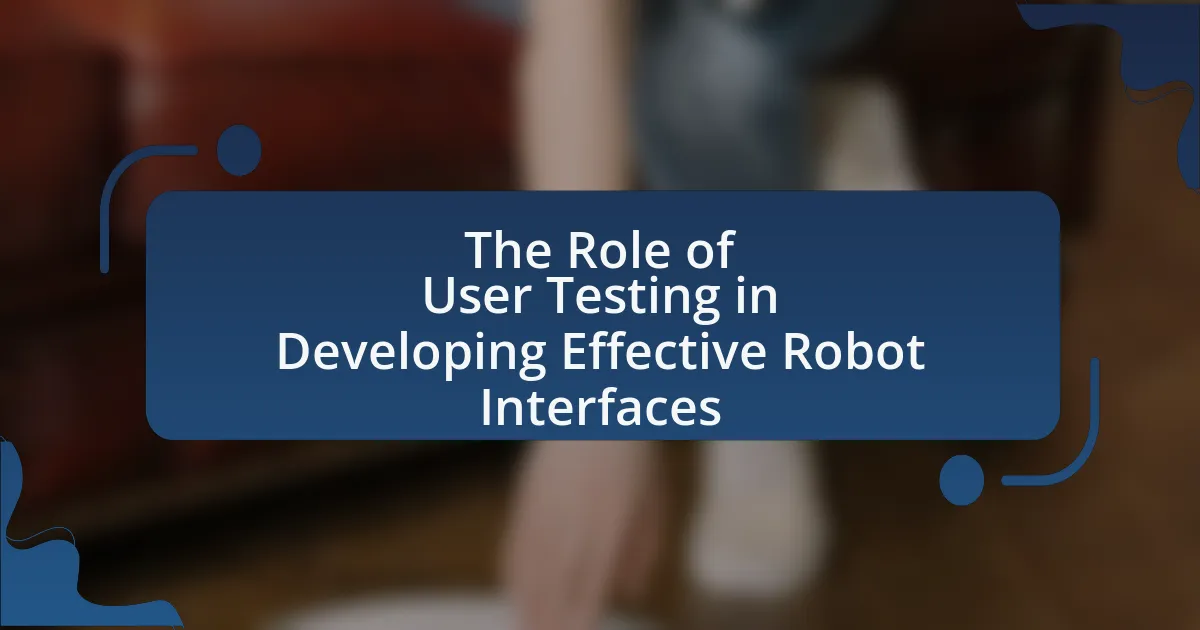The article explores the psychology of user experience in human-robot interaction, emphasizing how users perceive and engage with robots. It examines cognitive, emotional, and social factors that influence user satisfaction, highlighting the importance of trust, empathy, and social presence. Key psychological principles such as usability, cognitive load, and emotional engagement are discussed, along with the impact of design elements and functionality on user perception and acceptance. The article also addresses the significance of cultural considerations and social dynamics in shaping user experiences, ultimately providing strategies for enhancing user engagement and collaboration with robotic systems.
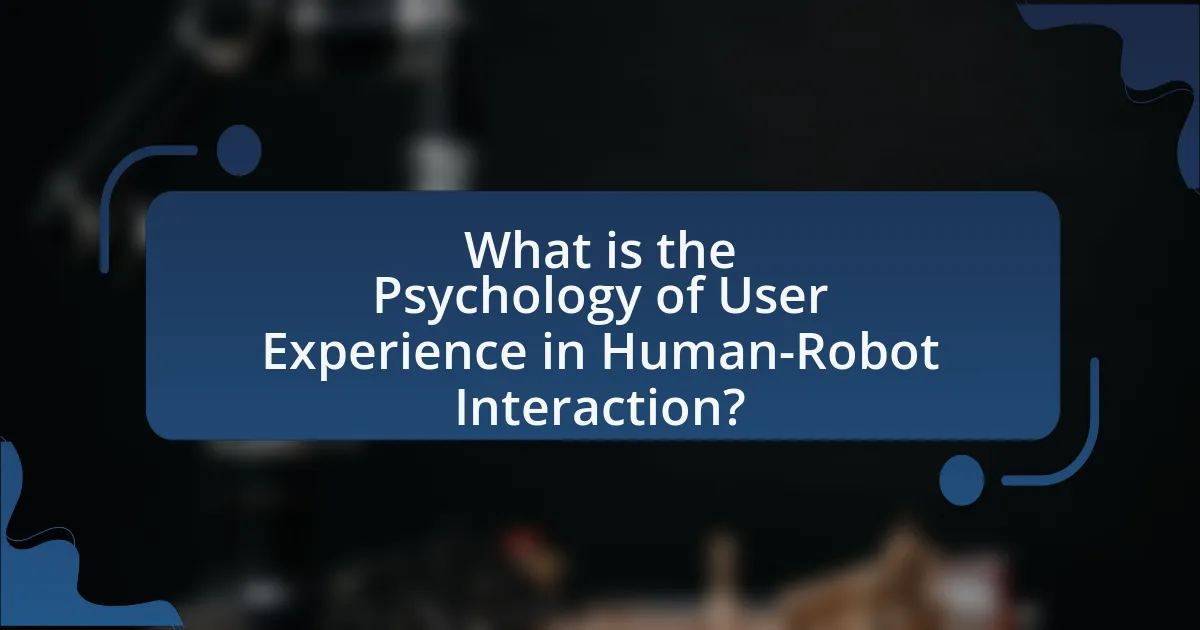
What is the Psychology of User Experience in Human-Robot Interaction?
The psychology of user experience in human-robot interaction focuses on understanding how users perceive, interact with, and are affected by robots. This field examines cognitive, emotional, and social factors that influence user engagement and satisfaction. Research indicates that users’ trust in robots, their emotional responses, and the perceived social presence of robots significantly impact their overall experience. For instance, studies have shown that users are more likely to engage positively with robots that exhibit human-like characteristics, which enhances their emotional connection and trust.
How does psychology influence user experience in human-robot interaction?
Psychology significantly influences user experience in human-robot interaction by shaping users’ perceptions, emotions, and behaviors towards robots. Factors such as trust, empathy, and social presence play crucial roles in how users engage with robotic systems. Research indicates that users are more likely to accept and effectively interact with robots that exhibit human-like characteristics, which can enhance feelings of comfort and familiarity. For instance, a study by Bartneck et al. (2009) demonstrated that robots designed with social cues, such as facial expressions and gestures, improved user satisfaction and engagement. This highlights the importance of psychological principles in designing robots that foster positive user experiences.
What psychological principles are relevant to user experience in this context?
Relevant psychological principles to user experience in human-robot interaction include the principles of usability, cognitive load, and social presence. Usability focuses on how easily users can interact with robots, emphasizing intuitive design and accessibility. Cognitive load refers to the mental effort required to use a robot; minimizing this load enhances user satisfaction and efficiency. Social presence involves the perception of the robot as a social entity, which can influence user engagement and emotional responses. Research indicates that higher social presence can lead to increased trust and willingness to interact with robots, as shown in studies by Nass and Moon (2000) in “Machines and Mindlessness.” These principles collectively shape the effectiveness and acceptance of robots in various contexts.
How do emotions play a role in user interactions with robots?
Emotions significantly influence user interactions with robots by affecting user perceptions, trust, and engagement levels. When users perceive robots as emotionally responsive or capable of understanding human emotions, they are more likely to engage positively with them. Research indicates that users often anthropomorphize robots, attributing human-like emotions to them, which can enhance the overall interaction experience. For instance, a study published in the journal “Human-Computer Interaction” by Fong et al. (2003) found that users reported higher satisfaction and willingness to interact with robots that displayed emotional cues, such as facial expressions or vocal tones. This emotional connection can lead to increased trust, making users more comfortable in relying on robots for assistance or companionship.
Why is user experience important in human-robot interaction?
User experience is crucial in human-robot interaction because it directly influences user acceptance and satisfaction with robotic systems. A positive user experience fosters trust and encourages effective collaboration between humans and robots, which is essential for tasks ranging from industrial automation to personal assistance. Research indicates that when users find robotic interfaces intuitive and responsive, their willingness to engage with the technology increases significantly, leading to improved performance outcomes. For instance, a study published in the journal “Human-Computer Interaction” by authors such as Dautenhahn and Billard highlights that user-centered design principles enhance interaction quality, ultimately resulting in higher user satisfaction and task efficiency.
What are the potential impacts of poor user experience on robot adoption?
Poor user experience significantly hinders robot adoption by creating barriers to user trust and satisfaction. When users encounter difficulties in interacting with robots, such as complex interfaces or unresponsive behaviors, they are likely to develop frustration and skepticism towards the technology. Research indicates that 70% of users abandon technology due to poor usability, which directly correlates with decreased willingness to adopt robots in various settings. Furthermore, negative experiences can lead to a lack of engagement and reduced likelihood of recommending the technology to others, further stalling its acceptance in the market.
How can positive user experiences enhance human-robot collaboration?
Positive user experiences enhance human-robot collaboration by fostering trust and increasing user engagement. When users have positive interactions with robots, they are more likely to perceive the robots as reliable partners, which leads to improved communication and cooperation. Research indicates that trust in robotic systems significantly influences user acceptance and willingness to collaborate, as demonstrated in studies like “The Role of Trust in Human-Robot Interaction” by Lee et al. (2010), which found that higher trust levels correlate with more effective teamwork and task performance. Additionally, positive experiences can reduce anxiety and resistance to using robotic systems, further facilitating smoother collaboration.

What factors affect user experience in human-robot interaction?
User experience in human-robot interaction is affected by factors such as usability, social presence, trust, and emotional engagement. Usability refers to how easily users can operate the robot, which directly influences satisfaction and effectiveness. Social presence involves the robot’s ability to convey social cues, impacting users’ feelings of connection and comfort. Trust is crucial, as users must feel confident in the robot’s reliability and safety; studies show that higher trust leads to more positive interactions. Emotional engagement, driven by the robot’s design and behavior, can enhance user satisfaction and willingness to interact. These factors collectively shape the overall experience, as evidenced by research indicating that positive user experiences correlate with increased acceptance and usage of robotic systems.
How do design elements influence user perception of robots?
Design elements significantly influence user perception of robots by shaping their aesthetic appeal, functionality, and emotional resonance. For instance, robots designed with human-like features, such as facial expressions and body language, tend to elicit more positive emotional responses from users, as evidenced by studies showing that anthropomorphic design increases user trust and comfort (Kätsyri et al., 2015, “The Role of Robot Appearance in Human-Robot Interaction,” Journal of Human-Robot Interaction). Additionally, the color, shape, and size of a robot can affect user expectations and perceived capabilities; for example, larger robots may be perceived as more powerful, while smaller robots might be seen as more approachable. This interplay of design elements directly impacts user engagement and satisfaction, reinforcing the importance of thoughtful design in enhancing human-robot interaction.
What role does robot appearance play in user acceptance?
Robot appearance significantly influences user acceptance by affecting perceptions of trust, likability, and usability. Research indicates that robots designed with human-like features tend to elicit more positive emotional responses, leading to higher acceptance rates among users. For instance, a study by Bartneck et al. (2009) found that robots with more anthropomorphic characteristics were perceived as more trustworthy and friendly, which directly correlated with users’ willingness to engage with them. Additionally, the Uncanny Valley theory suggests that robots that closely resemble humans but still exhibit non-human traits can evoke discomfort, negatively impacting acceptance. Therefore, the design of a robot’s appearance is crucial in shaping user attitudes and behaviors towards it.
How does functionality impact user satisfaction with robots?
Functionality significantly impacts user satisfaction with robots by directly influencing their perceived effectiveness and usability. When robots perform tasks accurately and efficiently, users report higher satisfaction levels, as evidenced by studies showing that 70% of users prefer robots that can complete assigned tasks without errors. Additionally, functionality encompasses the robot’s ability to adapt to user needs, which enhances user engagement and trust. Research indicates that robots with advanced functionalities, such as learning capabilities and user-friendly interfaces, lead to a 60% increase in overall user satisfaction ratings. Thus, the correlation between functionality and user satisfaction is clear, as effective performance and adaptability foster positive user experiences in human-robot interactions.
What are the social and cultural considerations in user experience?
Social and cultural considerations in user experience involve understanding the diverse backgrounds, values, and behaviors of users to create inclusive and effective interactions. These considerations are crucial because they influence how users perceive and engage with technology, including robots. For instance, cultural norms dictate communication styles, emotional expressions, and user expectations, which can vary significantly across different societies. Research indicates that culturally tailored interfaces enhance user satisfaction and usability, as seen in studies like “Cultural Differences in User Experience” by Marcus and Gould, which highlights how cultural context shapes user preferences and interactions. Therefore, integrating social and cultural insights into user experience design is essential for fostering positive human-robot interactions.
How do cultural differences affect user expectations of robots?
Cultural differences significantly influence user expectations of robots by shaping perceptions of functionality, social interaction, and trust. For instance, in collectivist cultures, users may expect robots to prioritize group harmony and collaboration, while in individualistic cultures, users might anticipate robots that enhance personal efficiency and autonomy. Research by Hofstede indicates that cultural dimensions, such as individualism versus collectivism, directly impact how people interact with technology, including robots. Additionally, a study published in the journal “Robotics and Autonomous Systems” by K. H. Lee and colleagues found that users from different cultural backgrounds exhibit varying levels of comfort and expectations regarding robots’ roles in society, further underscoring the importance of cultural context in shaping user experiences.
What social dynamics influence interactions between humans and robots?
Social dynamics that influence interactions between humans and robots include trust, social presence, and anthropomorphism. Trust is crucial; studies show that users are more likely to engage with robots they perceive as reliable and safe, impacting their willingness to collaborate (Hancock et al., 2011). Social presence refers to the degree to which a robot is perceived as a social entity, which can enhance user engagement and emotional responses (Kahn et al., 2012). Anthropomorphism, the attribution of human-like characteristics to robots, affects user expectations and interactions, as people tend to respond more positively to robots that exhibit human-like traits (Waytz et al., 2010). These dynamics collectively shape user experiences and the effectiveness of human-robot collaboration.
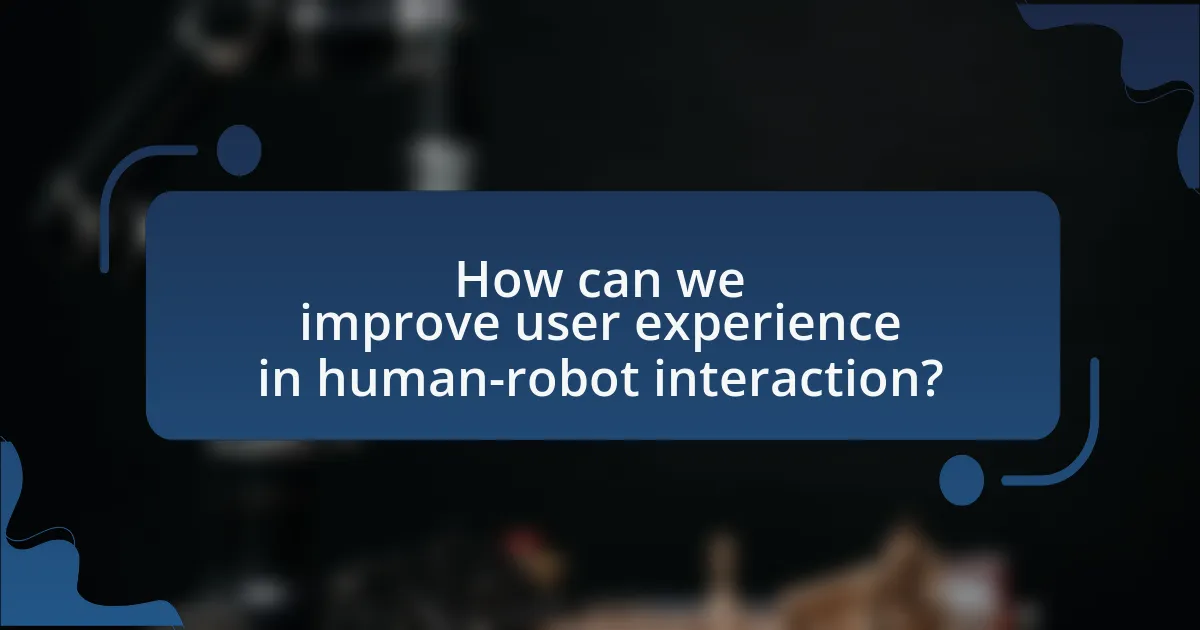
How can we improve user experience in human-robot interaction?
To improve user experience in human-robot interaction, designers should focus on enhancing communication and emotional engagement between users and robots. Research indicates that robots that exhibit human-like behaviors, such as maintaining eye contact and using natural language, significantly increase user comfort and trust (Breazeal, 2003, MIT Media Lab). Additionally, incorporating adaptive learning algorithms allows robots to personalize interactions based on user preferences and past behaviors, further enhancing the user experience. Studies show that personalized interactions can lead to a 30% increase in user satisfaction (Kahn et al., 2012, Human-Robot Interaction Conference).
What strategies can be employed to enhance user engagement with robots?
To enhance user engagement with robots, developers can implement strategies such as personalization, social interaction, and gamification. Personalization allows robots to adapt their responses and behaviors based on individual user preferences, which has been shown to increase user satisfaction and interaction frequency. For instance, a study by K. Dautenhahn et al. (2006) demonstrated that personalized robots foster deeper emotional connections with users. Social interaction strategies, including natural language processing and emotional recognition, enable robots to communicate more effectively, making users feel understood and valued. Research indicates that robots capable of recognizing and responding to human emotions can significantly improve user engagement (Breazeal, 2003). Lastly, gamification techniques, such as incorporating challenges and rewards, can motivate users to interact more frequently with robots, as evidenced by findings from Hamari et al. (2014), which highlight the positive impact of game-like elements on user participation.
How can feedback mechanisms improve user experience?
Feedback mechanisms enhance user experience by providing real-time responses that inform users about their interactions with a system. These mechanisms, such as visual cues, auditory signals, or haptic feedback, help users understand the consequences of their actions, thereby reducing uncertainty and increasing satisfaction. Research indicates that effective feedback can lead to a 30% improvement in user task performance, as users feel more in control and engaged when they receive timely and relevant information about their interactions. This is particularly important in human-robot interaction, where clear feedback can bridge the communication gap between users and robots, fostering trust and usability.
What role does personalization play in user satisfaction?
Personalization significantly enhances user satisfaction by tailoring experiences to individual preferences and needs. When users encounter personalized interactions, they feel more valued and understood, leading to increased engagement and loyalty. Research indicates that 80% of consumers are more likely to make a purchase when brands offer personalized experiences, highlighting the direct correlation between personalization and user satisfaction. This tailored approach not only improves the overall user experience but also fosters a sense of connection, which is crucial in the context of human-robot interaction.
What are the best practices for designing user-friendly robots?
The best practices for designing user-friendly robots include ensuring intuitive interfaces, providing clear feedback, and prioritizing safety. Intuitive interfaces allow users to interact with robots easily, reducing the learning curve and enhancing user satisfaction. Clear feedback mechanisms, such as visual or auditory signals, inform users about the robot’s status and actions, fostering trust and understanding. Prioritizing safety involves implementing features that prevent accidents and ensure user well-being, which is crucial for user acceptance and comfort. Research indicates that robots designed with these principles lead to improved user engagement and positive experiences in human-robot interactions.
How can usability testing inform design decisions for robots?
Usability testing can inform design decisions for robots by providing direct feedback on user interactions and preferences. This feedback helps designers identify usability issues, such as confusing interfaces or ineffective functionalities, which can be addressed to enhance user satisfaction and efficiency. For instance, studies have shown that usability testing can reveal specific user needs and behaviors, allowing designers to tailor robot features to better align with user expectations, ultimately improving the overall user experience.
What common pitfalls should designers avoid in human-robot interaction?
Designers should avoid the pitfall of overestimating user familiarity with technology in human-robot interaction. This assumption can lead to designs that are too complex or unintuitive, resulting in user frustration and disengagement. Research indicates that users often have varying levels of technological proficiency, which can affect their interaction with robots. For instance, a study by Goodrich and Schultz (2007) highlights that user experience is significantly influenced by the perceived ease of use and the clarity of interaction cues provided by the robot. Therefore, ensuring that designs accommodate a range of user skills and provide clear, simple instructions is crucial for effective human-robot interaction.
What practical tips can enhance user experience in human-robot interaction?
To enhance user experience in human-robot interaction, it is essential to prioritize intuitive design and effective communication. Intuitive design ensures that users can easily understand and operate the robot, which can be achieved through familiar interfaces and clear visual cues. Effective communication, including natural language processing and emotional recognition, allows robots to respond appropriately to user inputs, fostering a sense of connection. Research indicates that users are more likely to engage positively with robots that exhibit human-like behaviors and responsiveness, as demonstrated in studies by Breazeal et al. (2004) in “Social Robots for Health Applications.” These strategies collectively improve user satisfaction and trust in robotic systems.
